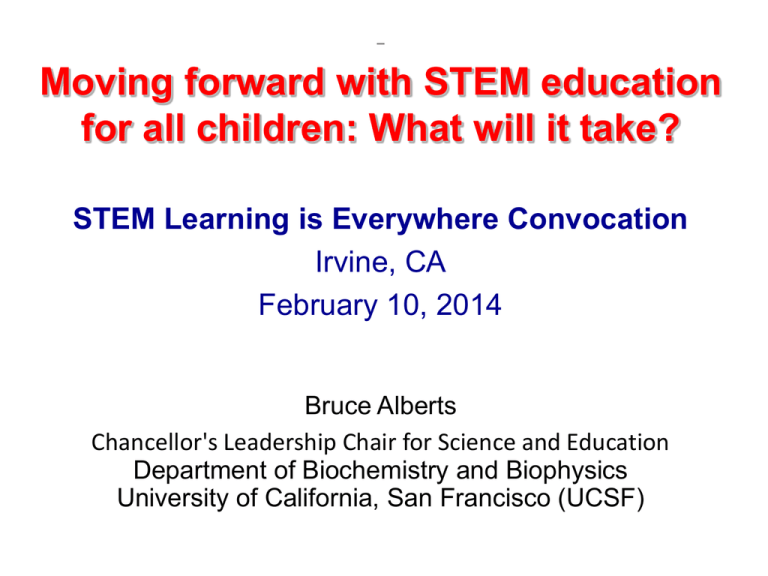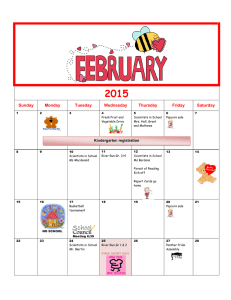Moving forward with STEM education STEM Learning is Everywhere Convocation Irvine, CA
advertisement

Moving forward with STEM education for all children: What will it take? STEM Learning is Everywhere Convocation Irvine, CA February 10, 2014 Bruce Alberts Chancellor's Leadership Chair for Science and Education Department of Biochemistry and Biophysics University of California, San Francisco (UCSF) The image we want for science Why? In part because every society needs much more of the creativity, rationality, openness, and tolerance that are inherent to science --what Indian Prime Minister Nehru called a “scientific temper” Three ambitious goals Through science education for all Americans: 1. Enable all children to acquire the problem-solving, thinking, and communication skills of scientists – so that they can be make their way through life making wise decisions, while also being productive and competitive in the new world economy. 2. Generate a “scientific temper” for our nation, ensuring the rationality and the tolerance essential for an effective democratic society. 3. Help to generate new scientific knowledge and technology by casting the widest possible net for talent. What science should look like in school What 5 year olds can do 1) Put on clean white socks and walk around school yard. 2) In class, collect all black specks stuck to socks and try to classify them: which are seeds and which are dirt? 3) Start by examining each speck with a 3 dollar, plastic “microscope”. 4) End by planting both those specks believed to be dirt and those believed to be seeds, thereby testing their own idea that the regularly shaped ones are seeds. The Vision Imagine an education that includes solving hundreds of such challenges over the course of the 13 years of schooling that lead to high school graduation – challenges that increase in difficulty as the children age. I believe that children who are prepared for life in this way would be great problem solvers in the workplace, with the abilities and the can-do attitude that are needed to be competitive in the global economy. Even more important, they will also be more rational human beings – people who are able to make wise judgments for their family, their community, and their nation. Some good news • This type of science education precisely fits the needs for workforce skills that have been widely expressed by US business and industry. The skills needed to be successful competitors in the modern world economy • A high capacity for abstract, conceptual thinking. • The ability to apply that capacity for abstract thought to complex real-world problems—including problems that involve the use of scientific and technical knowledge—that are nonstandard, full of ambiguities, and have more than one right answer. • The capacity to function effectively in an environment in which communication skills are vital – in work groups. Ray Marshall and Marc Tucker, Thinking for a Living, 2002 But there is also bad news • Adults have incorrectly defined what “science education” means for most students. A Disturbing Recent Fact A third grade student comes home from school and tells his mother: “Now I get it, science is just like spelling; you just need to memorize it and it doesn’t make any sense.” My field is cell biology. The cell is the basic unit of life. Middle school students should come into contact with real cells, and learn how amazing they are -- as well as how they work in general. But instead we try to fill their heads with all the names of their parts and their processes. The result: science education as “mentioning” From a 7th grade life sciences textbook: “Running through the cell is a network of flat channels called the endoplasmic reticulum. This organelle manufacturers, stores and transports materials.” Supported by trivial tests From the Chapter Self-Test: “Write a sentence that uses the term endoplasmic reticulum correctly”. From 2008-2013, I tried to ask “How can Science magazine help to promote the needed revolution in science education?” It was great to have control of the editorial page! Promoting much better science education How Science magazine has tried to help 24 monthly winners of SPORE contest for best free science education websites ) The last of 4 special issues on education Reading an actual scientific article should be part of science education • The Framework for the NGSS emphasize the Practice of Science and active science learning. • All high school students are to “engage in a critical reading of primary scientific literature or of media reports of science and discuss the validity and reliability of the data, hypotheses, and conclusions.” “Science in the Classroom” 8 articles now available Features include a “Learning Lens”, with guidance that one can turn on and off Expanded figures include further explanations An open-access website to know http://portal.scienceintheclassroom.org/ One critical challenge today • It is much easier to test for science words than for science understanding and abilities. • Bad tests force a trivialization of science education and drive most students, including many potential scientists, away from science. An urgent need to produce new assessments for the “Practice of Science” component of the NGSS There is also the critical issue of teacher empowerment • Some 40 years ago, US industry learned from the Japanese that building a better automobile requires listening to workers on the assembly line – ground truth is essential for wise decision making! • Education is one of the few parts of our society that has failed to exploit this fact. What keeps me up at night • Our best science teachers need to have much more influence on the education system; current trends will drive these talented people into more lucrative and respected careers. • This influence is needed at every level: from school districts, to States, to the Federal Government. • How can we institutionalize such an influence, as needed to create a continuously improving education system? A national Teacher Advisory Council Every State and District also needs one! A California Teacher Advisory Council (CalTAC) provides a state model • Sponsored by the California Council on Science and Technology (CCST), a state version of the National Academies in Washington, DC. • Making connections to legislators and education leaders in Sacramento. The Amazing Power of ScienceEducation Partnerships • Scientists and engineers are urgently needed to support teachers. • And we all have a great deal to learn from outstanding teachers of children age 5 to 18 that will improve our own teaching. UCSF’s 25 year-old Science Education Partnership Each year: • Scientist volunteers contribute >10,000 hours • Are active in 90% of SFUSD schools • Benefit ~21,000 students – 40% of SFUSD K-12 Student Population • Involve >350 Teachers and > 250 UCSF Volunteers School of Medicine 30 What I have learned about partnerships 1. Any effective partnership requires that the partners deeply respect and honor each other’s unique expertise. (e.g., scientists and science education researchers) 2. Funding agencies must work to decrease the strong incentives for “uniqueness”, an enemy of coherence. (e.g., overcome the “not invented here” aversion to copying outstanding programs) 3. Partnerships flourish best when the partners can focus on accomplishing an important discrete task. (e.g., schools, informal sector, and after school programs working together to create a powerful STEM Badge program across the U.S.) The dream: can a child’s science education serve to impart scientific values? “The society of scientists is simple because it has a directing purpose: to explore the truth. Nevertheless, it has to solve the problem of every society, which is to find a compromise between the individual and the group. It must encourage the single scientist to be independent, and the body of scientists to be tolerant. From these basic conditions, which form the prime values, there follows step by step a range of values: dissent, freedom of thought and speech, justice, honor, human dignity and self respect. Science has humanized our values. Men have asked for freedom, justice and respect precisely as the scientific spirit has spread among them.” Jacob Bronowski, Science and Human Values, 1956 More good news • Major changes are underway in introductory science courses in U.S. colleges and universities. Interactive, “no lecture” science classroom University of Minnesota Robin Wright, Dean of Biology Education (22 tables, each with 9 chairs, two computers, overhead screen) Active learning in college Biology 1 class




